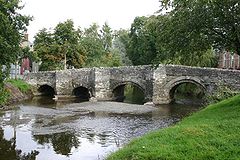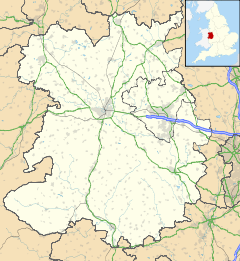- Clun
-
Coordinates: 52°25′17″N 3°01′47″W / 52.4214°N 3.0297°W
Clun 
Clun Bridge over the River Clun
 Clun shown within Shropshire
Clun shown within ShropshirePopulation 642 (2001 Census) OS grid reference SO302808 Parish Clun and Chapel Lawn Unitary authority Shropshire Ceremonial county Shropshire Region West Midlands Country England Sovereign state United Kingdom Post town CRAVEN ARMS Postcode district SY7 Dialling code 01588 Police West Mercia Fire Shropshire Ambulance West Midlands EU Parliament West Midlands UK Parliament Ludlow List of places: UK • England • Shropshire Clun (
 /ˈklʌn/) is a small town in Shropshire, England. The town is located entirely in the Shropshire Hills Area of Outstanding Natural Beauty. The 2001 census recorded 642 people living in the town. Research by the Campaign for the Protection of Rural England suggests that Clun is one of the most tranquil locations in England.[1]
/ˈklʌn/) is a small town in Shropshire, England. The town is located entirely in the Shropshire Hills Area of Outstanding Natural Beauty. The 2001 census recorded 642 people living in the town. Research by the Campaign for the Protection of Rural England suggests that Clun is one of the most tranquil locations in England.[1]Contents
Geography
The town's name is taken from that of the River Clun (Welsh: Colunwy), which flows from west to east through the settlement. The Clun Valley is dominated by agriculture, though some areas of woodland remain. The River Unk joins the Clun just to the west of the town.
The A488 and B4368 roads cross in the town of Clun. Craven Arms, Bishop's Castle (6 miles (10 km) to the north) and Ludlow are the neighbouring Shropshire towns, and Knighton, which is in Wales, is 7 miles (11 km) to the south. Nearby is Offa's Dyke and the Offa's Dyke Path. Clun Forest is to the west of the town, further upstream of the Rivers Unk and Clun. The Jack Mytton Way passes through the town as does the Shropshire Way and further significant historic routes pass through the area.
The town centre on the north bank of the River Clun lies 185 m above sea level while the oldest part of the settlement, by St George's church on the south bank, is a little more elevated, at 193 m. Between the two, Clun Bridge (181 m above sea level) carries the A488 and B4368 routes across the river.
In addition to Clun Bridge there is also a ford further downstream, at Waterloo, which has recently been made usable to most motor vehicles, and a third crossing point, a footbridge just upstream of Clun Bridge, connects the town's main car park to the castle grounds.
Population
The population of the parish of Clun and Chapel Lawn was 1086 as measured by the 2001 census, of which the population of the town itself was 642. This is a population normally associated with that of a village. It is said that the population of the town is now smaller than it was during the flourishing days of the wool trade in England centuries ago. The town is the smallest town in Shropshire and is smaller than many villages in the county. It is also the only town in Shropshire never to have had a railway line or station.
Attractions
Attractions in the town include:
- the Norman Clun Castle, now only a ruin but with grounds which are used for the May fair
- the fifteenth century Clun Bridge (basically a packhorse bridge), most of which is still the original stone despite being a road bridge today used by all vehicles
- Trinity Hospital, almshouses built in 1614, on Hospital Lane
- a museum in the Town Hall, on the corner of The Square and High Street
The main church in the town is St George's Church, which is situated on the steep rise out of the town ("Church Street") to the south of Clun Bridge.
Clun is a popular starting point for walkers who wish to explore the Shropshire Way, the Jack Mytton Way or the local circular walks. A walkers car park is situated at the Memorial Hall.
Facilities
The main streets in the town are Enfield Street, The Square, High Street, Ford Street, Bridge Street and Church Street. Along these streets are a number of shops, including butchers, antique shops, a hair salon, a convenience store and a newsagent. There is also a post office and two tea rooms. On the Craven Arms Road there are a number of businesses (mostly at "The Green Industrial Estate"), including "Clun Garage", as well as the local fire station.
There were three pubs in the town until recently - the Sun Inn,[2] the White Horse Inn,[3] and the Buffalo Head Hotel ("the Buffalo"). However, the Buffalo has been closed since about 2004, but has not yet been converted into another use.
The town has a primary school ("St George's"), a community centre (the "Memorial Hall") and there is also a Youth Hostel at Clun Mill, just to the north of the town.
For visitors and tourists there is a car park on the B4368 Newcastle Road, near Clun Bridge, where there are public toilets.
Festivals
Over the three days of the first May bank holiday every year, the Green Man festival is held. On the bank holiday Monday the Green Man enters Clun to battle the spirit of winter at Clun Bridge and a May fair is held in the grounds of Clun Castle with a May Queen.[4]
The first Saturday in August every year sees the Clun Carnival take place with a procession through the town's streets and a fete at the playing fields to the north of the town.
The first weekend in October sees the Clun Valley Beer Festival[5] which takes place in the seven open pubs of the valley (from Anchor to Aston on Clun).
Related uses of the name
See also: Clun Forest sheepClun is also a term used sometimes for the extreme southwest part of the county of Shropshire. Shropshire Council has an electoral division called Clun which covers Clun and the surrounding parishes. From the 2009 elections this electoral division will continue to exist, though will be slightly smaller. The electoral division returns one councillor to the council. The term "Clun Valley" is also used for the villages and communities along the River Clun - such as Anchor, Newcastle and Aston on Clun.
Notable people
- John Osborne, playwright, lived near Clun and is buried at St. George's Church and his tombstone is located to the right of the main building entrance
- Duke of Norfolk is Baron of Clun
- Earl of Powis is the Lord of the Manor
- Bruce Bairnsfather, war cartoonist, creator of the "Old Bill" cartoons, resided at Cresswell House in Clun during part of WWII. At this time he was contributing to the American Forces newspaper "Stars & Stripes"
- Sir Robert Howard inherited Clun Castle in 1626 from his brother[6] and has a memorial in the church
- William Baker former Tottenham Hotspur Manager
In culture
- In A Shropshire Lad, A. E. Housman wrote the verse:
“ Clunton and Clunbury,
Clungunford and Clun,
Are the quietest places
Under the sun.” - In Douglas Adams' book The Meaning of Liff, Clun is listed as "a leg that has gone to sleep that you have to drag around behind you".
- E. M. Forster visited Clun, which subsequently featured as Oniton in his novel Howards End (1910).
- Sir Walter Scott is believed to have stayed in The Buffalo Inn while writing The Betrothed and The Talisman, published jointly as Tales of The Crusaders in 1825. Clun castle is supposed to have inspired Scott's Garde Doleureuse in that work.
Nearby settlements
Destinations from Clun 
Cefn Einion, Mainstone Colebatch
Bishop's CastleLydbury North
Shrewsbury (county town)
Whitcott Keysett, Newcastle, Bettws-y-crwyn, Anchor 
Clunton, Clunbury, Purslow, Aston on Clun
Craven Arms Clun
Clun 

Llanfair Waterdine, Knucklas New Invention
KnightonBucknell, Bedstone, Leintwardine References
- ^ Campaign for the Protection of Rural England. "Tranquillity map: Shropshire". http://www.cpre.org.uk/campaigns/landscape/tranquillity/national-and-regional-tranquillity-maps/county-tranquillity-map-shropshire. Retrieved 19 July 2009.
- ^ "The Sun Inn". http://thesunatclun.co.uk/. Retrieved 11 March 2008.
- ^ "The White Horse Inn". http://www.whi-clun.co.uk/. Retrieved 13 August 2008.
- ^ Clun Green Man Festival website
- ^ "Clun Valley Beer Festival". http://www.cvbf.co.uk/. Retrieved 13 August 2008.
- ^ H. M. Chichester, ‘Howard, Sir Robert (1584/5–1653)’, rev. Sean Kelsey, Oxford Dictionary of National Biography, Oxford University Press, 2004 accessed 14 May 2010
External links
- Clun and Chapel Lawn Parish Council
- Shropshire Tourism (the official tourism website for Shropshire)
- Official Local Clun Site
- Clun and South Shropshire for tourists
- Clun Green Man Festival
- History of Clun
- Photographs of Clun on Shropshire Gallery
Ceremonial county of Shropshire Boroughs or districts Major settlements Bishop's Castle • Bridgnorth • Broseley • Church Stretton • Cleobury Mortimer • Clun • Craven Arms • Ellesmere • Ludlow • Market Drayton • Much Wenlock • Newport • Oswestry • Shifnal • Shrewsbury • Telford (Dawley • Madeley • Oakengates • Wellington) • Wem • Whitchurch
See also: List of civil parishes in ShropshireRivers Topics Categories:- Towns in Shropshire
- Towns of the Welsh Marches
Wikimedia Foundation. 2010.

